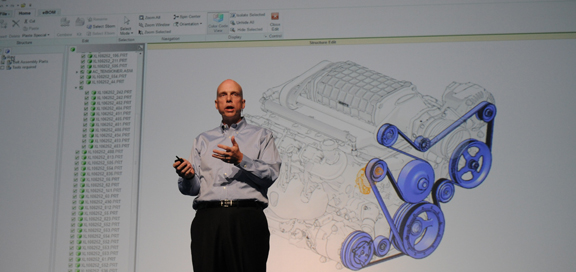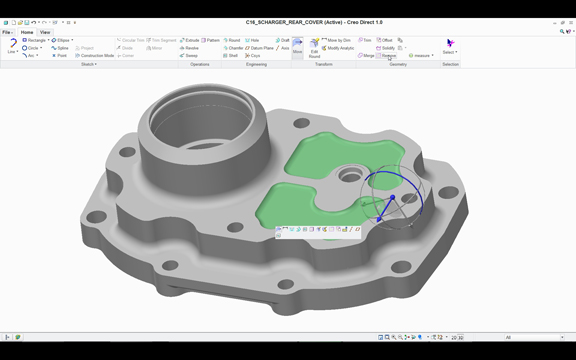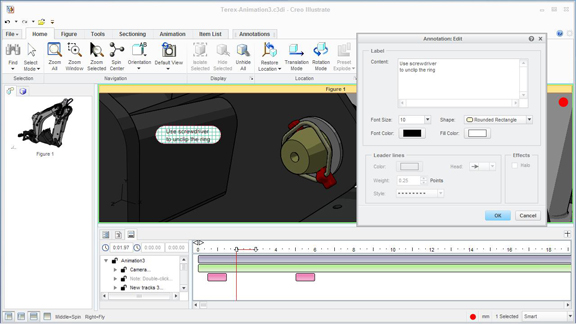Latest News
June 14, 2011


This week, PlanetPTC Live (June 12-15, Las Vegas, Nevada), PTC’s annual user conference, got underway in Caesars Palace, under the watchful gazes of Neptune, Jupiter, Apollo, and Juno—marbled Roman gods and goddesses guarding the walkway between the casino floor and the conference rooms.
It’s been eight months since PTC publicly announced its Creo campaign, an ambitious plan to retake the market. The company was betting on an untested strategy, to break up its long-established flagship product Pro/ENGINEER into a series of lighter, nimbler, easier apps—the corporate equivalent of splitting a battle-hardened legion into smaller, faster cavalry, archery, and infantry troops.
Creo is, in the words of Brian Shepherd, PTC’s executive VP of product development, “PTC’s goal to revolutionize the mechanical CAD industry once again, by ushering the next wave of mechanical design tools.” He acknowledged, “There were both a lot of excitement and skepticism” about Creo among its own customers.
On Monday, Shepherd proved Creo was not a bluff. He finally showed PTC’s hand. Creo 1.0, the first incarnation, came in nine apps:
- Creo Sketch, for simple freehand sketches of ideas and design concepts in 2D;
- Creo Layout, for capturing early concept in 2D layout (with the aim to further develop them in 3D);
- Creo Parametric, for 3D parametric modeling (the successor to Pro/ENGINEER);
- Creo Direct, for fast, flexible 3D geometry creation and editing using direct modeling (data exported is interoperable with Creo Parametric);
- Creo Simulate, for conducting structural and thermal simulation;
- Creo Schematics, for creating 2D systems diagrams for piping and cabling designs;
- Creo Illustrate, for 3D technical illustrations (a spawn of Arbotext);
- Creo View ECAD, for viewing, interrogating, and marking up electronic design; and
- Creo View MCAD, for viewing, interrogating, and marking up mechanical design.



“Creo’s role based apps make a typically closed process open and inclusive, enabling more people to make a meaningful contribution to product designs,” said Shepherd. “This is a huge advance that will help our customers create better designs, and ultimately better products.”
The apps are standalone products. They do not require PTC’s Windchill PLM to operate, but they work well with Windchill, according to Shepherd.
Creo Sketch and Creo Layout are scheduled to be available in July and late fall this year, respectively. The rest are available now. PTC hasn’t published prices for all apps, but at least one app, Creo Sketch, is set to be distributed for free, for both Windows (PTC’s traditional operating OS) as well as Mac OS.
By offering Creo Sketch for free, PTC may be targeting the 2D market long dominated by AutoCAD and AutoCAD LT. The emergence of other free 2D tools—IMSI/Design’s DoubleCAD XT and Dassault Systemes’ DraftSight, to name but two—may have also influenced the company to give away 2D without charge.
According to Mike Campbell, head of product development for Creo, the growth in year-to-year sales of its direct modeler (+96%) significantly outpaces other business units. By developing a brand new direct modeling app from scratch (instead of refining its existing Creo Elements/Direct, formerly known as CoCreate), PTC is putting in place the necessary software architecture to ensure that geometry authored in its direct modeler and parametric modeler (Creo Direct and Creo Parametric) are interoperable. In other words, when you import a model created in PTC’s direct modeler into PTC’s parametric modeler, the later would have a way to interpret your geometry as parametric steps and provide you with a feature tree—even though you may have created your design with little or no regard for parametric steps. (It’s similar to the strategy adopted by Autodesk with Inventor Fusion, and by Siemens PLM Software with Synchronous Technology.)
Being a newly developed app, Creo Direct currently remains an introductory product to direct modeling, not comparable to Creo Elements/Direct in its feature sets. Over time, as Creo Direct becomes a mature products, PTC plans to make it a logical successor to CoCreate. But that, as Shepherd explained it, “is still years away.”
During the unveiling of its Creo strategy last October, PTC previewed, among others, a rendering app—something the company still plans to deliver as part of its Creo business. Following the Apple app store model, PTC will recruit partners who can build other Creo apps. How they get distributed remains undecided at present.
Shepherd is also looking at some Creo apps for mobile device deployment. For enterprise collaboration and data management, Windchill Mobility for the iPad is already in the work. It integrates the Creo viewers to enable CAD data visualization. A mobile app for interacting with 3D service manuals and instructions authored in Creo Illustrate may be on the way.
For PTC, historically known for its all-encompassing parametric modeler Pro/E, the Creo campaign carries a lot of risks as well as opportunities. Perhaps Caesar—who, the form of a life-size bronze statue, hails conference attendees at the hotel’s gate—might agree that sometimes doing the unexpected is the best way to rattle your enemies.
For more product screenshots of the first batch of Creo apps, watch the slide show below.
Subscribe to our FREE magazine, FREE email newsletters or both!
Latest News
About the Author
Kenneth Wong is Digital Engineering’s resident blogger and senior editor. Email him at [email protected] or share your thoughts on this article at digitaleng.news/facebook.
Follow DE





